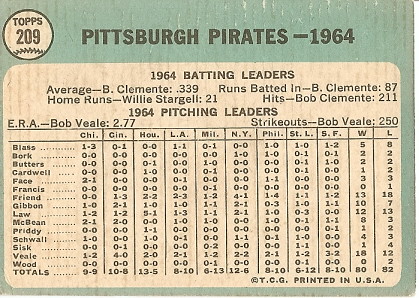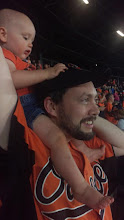
The Pirates batted .264, good for third in the league. Their 54 triples topped the senior circuit, compensating for a sixth-place rank in home runs (121 total). Of course, the star of the team was right fielder Roberto Clemente, who led the way with a .339 average (best in the NL), 95 runs scored, and 87 RBI. Other above-average performers were catcher Jim Pagliaroni (.295), first baseman Donn Clendenon (.282), third baseman Bob Bailey (.281), and left fielder Jerry Lynch (.273, 16 HR). Oh, and there was a second-year outfielder/first baseman named Willie Stargell who paced the team with 21 home runs. He and Clemente would play in the All-Star Game. Catcher Smoky Burgess and second baseman Bill Mazeroski were also selected, but did not play. Maz and Clemente gave Pittsburgh two Gold Glove winners.
Manager Danny Murtaugh's team had a middle-of-the-pack pitching staff; their 3.52 ERA placed them seventh in the league. Bob Veale was the standout amongst the group, winning 18 with a 2.74 ERA (eighth in the N.L. in both categories). In his first full season as a starter, he topped the loop in strikeouts (250), but also in walks allowed (124). Al McBean was the fireman in the bullpen, winning eight and saving twenty-two more (second in the league behind Houston's Hal Woodeshick) with a 1.91 ERA.
In 1965, Harry "the Hat" Walker, a former NL batting champ, would take over at the Pirates' helm and guide the team to two straight years with 90-plus wins. But they wouldn't return to the postseason until 1970, when Murtaugh celebrated his return with an Eastern Division title, beginning a run of five playoff appearances in six years. Pittsburgh would be World Champions in 1971 and 1979, both times at the expense of my Orioles in seven-game thrillers. Bah. 



I used to love studying the back of those old Topps team cards that had the pitchers vs. opponents records. I'm not sure why they held such a fascination for me.
ReplyDelete